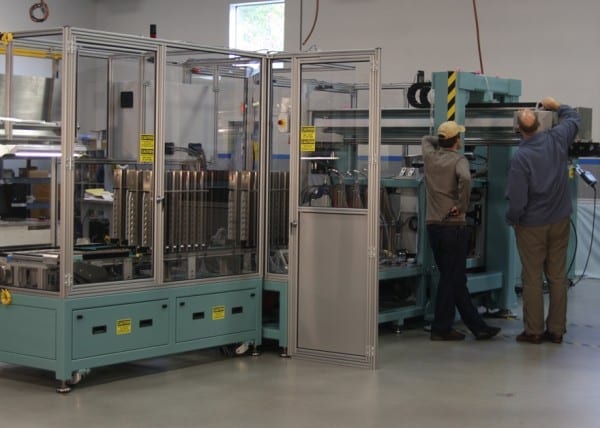Manufacturing automation is a system of manufacturing that utilizes the application of advanced systems, machine design, and technology to automate tasks and processes in any production environment. Automated production processes do more than assemble John Deere tractors or Ford cars. Automation can be achieved on a basic level in fabrication shops as well as in a large-scale manufacturing environment.

Manufacturing automation can be applied to machine tools such as adding a bar feeder to a lathe. It can include a robotic system that applies labels at astonishing speeds and even automatically packages final products after they’ve been labeled. By transitioning to manufacturing automation in a factory, facility, shop, warehouse, or plant, companies can realize an increase in production and efficiency, reduced lead times, improved quality, become more competitive, and provides a safer workplace for employees.
For many companies that transition toward manufacturing automation is well underway. There are pros and cons, and drawbacks and benefits. Very real challenges do exist in implementing manufacturing automation. Considerations can range from initial investment, floor space, what process should be automated to training or finding skilled employees to general employee fears and resistance.
Automation Drawbacks
Investment
Initial investment in manufacturing automation may cause hesitation or postponement in transitioning to automating production processes. Depending on the degree or type of automation, the investment could vary greatly. Costs for powering the system and added monthly overhead must be considered, as well.
Flexibility
Automation systems are highly specialized to complete a specific task or function. Fixed or programmable manufacturing automation is especially limited to particular production runs. Because of this, automation machines, while more productive, are perceived as less versatile than an expanded team of employees.
Ethical Perception
Unemployment or an employment dilemma, call it what you like. Manufacturing automation is sometimes perceived as negative because of the direct effect it has in decreasing the number of employees required to perform manual tasks of loading or unloading products, packaging, warehousing, etc.
Unknown Expenses
Implementing any new technology, program or business model comes with some level of unpredictability. Research and development for automation processes, preventive and routine maintenance costs, and the cost of cross-training employees to operate automated machines must all be considered as part of the investment.
Automation Benefits
Labor
This should be at the top of every list of advantages to manufacturing automation: it creates a demand for skilled labor, maintenance, and service technician jobs. Automation promotes the need for skilled trades to perform the jobs required in factories, plants, and shops. It also eliminates the often dangerous manual tasks long associated with standing in factory production lines. Redundant jobs are eliminated by automation, yet opportunities exist for workforces to obtain and develop skills that will benefit them as well as give companies a competitive edge. Companies may also be eligible for or to take advantage of government sponsored or aided programs and incentives to cross-train their workforce rather than laying them off.
Increased Competitiveness and Profits
Automation provides a more competitive position for companies. As production processes become more automated, human error is reduced and product quality rises and becomes more consistent. With less error and more demand for material, the cost per part decreases by volume. The reduction in resources required to produce the goods, i.e., parts and labor, will increase profits.
Increased Production
Automation greatly reduces production time and increases output. Manufacturing automation is more capable of producing much larger production volumes than a human workforce. When the demand is there, an increase in production is an increase in a company’s profit margin.
Product Quality
Manufacturing automation improves the product quality. When a machine is programmed to perform a repeated task it does so with precision, accuracy, and repeatability without human error.
Improved Work Environment
Automation improves working conditions and provides a safer work environment for employees. Less interaction with machines and equipment that once caused serious injuries is removed. Automation can reduce health and safety risks associated with manual handling and the risk of repetitive strain injuries.
In total, the benefits to manufacturing automation outweigh the challenges presented by the transitioning to the system. It eliminates redundant tasks once performed by employees, replaces them with automated processes, and subsequently presents an opportunity to cross-train those employees to higher skilled jobs. Increasing efficiency and production means an increase in productivity and profits. More efficient production processes leads to the increased output necessary for manufacturers to be more competitive in their market.
Machine Vision Integrators